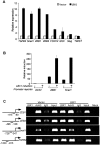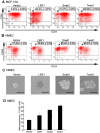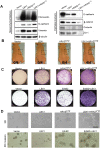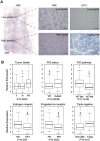A developmentally regulated inducer of EMT, LBX1, contributes to breast cancer progression - PubMed (original) (raw)
A developmentally regulated inducer of EMT, LBX1, contributes to breast cancer progression
Min Yu et al. Genes Dev. 2009.
Abstract
Epithelial-to-mesenchymal transition (EMT) plays an important role during normal embryogenesis, and it has been implicated in cancer invasion and metastasis. Here, we report that Ladybird homeobox 1 (LBX1), a developmentally regulated homeobox gene, directs expression of the known EMT inducers ZEB1, ZEB2, Snail1, and transforming growth factor beta2 (TGFB2). In mammary epithelial cells, overexpression of LBX1 leads to morphological transformation, expression of mesenchymal markers, enhanced cell migration, increased CD44(high)/CD24(low) progenitor cell population, and tumorigenic cooperation with known oncogenes. In human breast cancer, LBX1 is up-regulated in the unfavorable estrogen receptor (ER)/progesterone (PR)/HER2 triple-negative basal-like subtype. Thus, aberrant expression of LBX1 may lead to the activation of a developmentally regulated EMT pathway in human breast cancer.
Figures
Figure 1.
LBX1 induces EMT in mammary epithelial cells. (A) LBX1 induces morphological changes in MCF-10A cells. MCF-10A cells were infected with vector or LBX1 retroviral expression constructs and cultured in plastic dishes. Bar, 100 μm. (B) LBX1 induces changes of EMT markers in MCF-10A cells. Expression of various epithelial and mesenchymal markers were analyzed by Western blotting. (C) LBX1 enhances the migration of MCF-10A cells. Vector- or LBX1-expressing cells were plated on top of a transwell chamber in media without EGF for 2 d. Images show cells migrated to the bottom of the chamber. (D) LBX1 mRNA expression was evaluated in MCF-10A and MDA-MB-231 cells by RT–PCR. (E) Efficiency of knocking down LBX1 level in MDA-MB-231 cells by shRNAs. ShRNA constructs against luciferase (shLuc) and LBX1 (shLBX1) were introduced into MDA-MB-231 cells by lentiviral infection and relative expression of LBX1 mRNA was measured by real-time qRT–PCR. Error bars represent mean ± SD of triplicate experiments. (F) Suppression of LBX1 in MDA-MB-231 cells inhibits migration. Migration assay of MDA-MB-231 cells with shLuc or shLBX1. Cell numbers migrated to the bottom of the chambers ± SD of triplicate experiments are indicated.
Figure 2.
LBX1 directly up-regulates the expression of other EMT inducers. (A) qRT–PCR showing relative mRNA expression levels of known EMT inducers in MCF-10A cells expressing vector or LBX1. Error bars represent mean ± SD of triplicate experiments. (B) LBX1 acts as transcriptional inducers of ZEB1 and Snail1. HEK293T cells were transiently cotransfected pWPI vector or pWPI-LBX1 construct together with pGL4.15 backbone, or ZEB1 and Snail1 promoters. Relative luciferase activity is shown. Error bars represent mean ± SD of triplicate experiments. (C) LBX1 binds to the promoters of ZEB1, ZEB2, Snail1, and TGFB2 evaluated by ChIP. Antibodies against LBX1, acetylated histone H3 (AcH3), and corresponding IgG were used in vector- and LBX1-expressing MCF-10A cells to immunoprecipitate the corresponding protein-bound genomic DNA. PCR products corresponding to the promoter region are illustrated in the left panel.
Figure 3.
LBX1 overexpression in mammary epithelial cells enhances stemness. (A) Flow cytometric evaluation of CD44high/CD24low population in MCF-10A cells expressing vector, LBX1, Snail1, or Twist1. Percentages of mean CD44high/CD24low population ± SD of triplicate experiments are indicated. (B) Flow cytometric evaluation of CD44high/CD24low population in HMEC cells expressing vector, LBX1, Snail1, or Twist1. Percentages of mean CD44high/CD24low population ± SD of triplicate experiments are indicated. (C) Representative images of mammospheres formed by HMEC cells. Bar, 100 μm. (D) Quantification of mammosphere numbers for HMEC cells. Error bars, mean ± SD of triplicate experiments.
Figure 4.
Oncogenic cooperation by LBX1. Cell lines were generated by sequentially infecting MCF-10A cells with retroviral pBabe vector (vector), pBabe-LBX1 (LBX1), and lentiviral pMSCV-HRASV12 construct (HRASV12 or LBX1 + HRASV12). ErbB2-overexpressing MCF-10A cells were infected with pBabe-vector (ErbB2) or pBabe-LBX1 (ErbB2 + LBX1). (A) Immunoblotting of cell lysates for different EMT markers. (B) Cells (5 × 106) were subcutaneously grafted into Swiss nude mice. The number of mice developing tumors is indicated. The boxes illustrate the injection area at 3 mo. (C) Transwell migration assays (2 d). (D) Cells were cultured in 3D culture (3D) on Matrigel for 4 d or 3D invassion assay on Matrigel/collagen mix for 6 d. Bars, 100 μm.
Figure 5.
LBX1 expression level is associated with invasive subtype of human breast cancer. (A) Human breast tumor sample examined by hematoxylin and eosin stain (H&E) and in situ hybridization for LBX1 (LBX1). The left panel shows low magnification H&E-stained tumor. Higher magnification of the adjacent low-grade and high-grade tumor regions is shown in the right panel for H&E (histology) and in situ hybridization with probes against LBX1 mRNA. (B) Microarray analysis in human breast tumors for correlation of LBX1 expression level with different known prognostic factors. Relative expression of LBX1 mRNA level was compared in different groups according to tumor grade, P53 mutation status, P53 pathway status, estrogen receptor, progesterone receptor, and triple-negative status by box plotting. _P_-values analyzed by Kruskal-Wallis test were indicated.
Similar articles
- Fra-1/AP-1 induces EMT in mammary epithelial cells by modulating Zeb1/2 and TGFβ expression.
Bakiri L, Macho-Maschler S, Custic I, Niemiec J, Guío-Carrión A, Hasenfuss SC, Eger A, Müller M, Beug H, Wagner EF. Bakiri L, et al. Cell Death Differ. 2015 Feb;22(2):336-50. doi: 10.1038/cdd.2014.157. Epub 2014 Oct 10. Cell Death Differ. 2015. PMID: 25301070 Free PMC article. - Epithelial-mesenchymal transition and tumor suppression are controlled by a reciprocal feedback loop between ZEB1 and Grainyhead-like-2.
Cieply B, Farris J, Denvir J, Ford HL, Frisch SM. Cieply B, et al. Cancer Res. 2013 Oct 15;73(20):6299-309. doi: 10.1158/0008-5472.CAN-12-4082. Epub 2013 Aug 13. Cancer Res. 2013. PMID: 23943797 Free PMC article. - Epithelial and mesenchymal subpopulations within normal basal breast cell lines exhibit distinct stem cell/progenitor properties.
Sarrio D, Franklin CK, Mackay A, Reis-Filho JS, Isacke CM. Sarrio D, et al. Stem Cells. 2012 Feb;30(2):292-303. doi: 10.1002/stem.791. Stem Cells. 2012. PMID: 22102611 - Restin suppressed epithelial-mesenchymal transition and tumor metastasis in breast cancer cells through upregulating mir-200a/b expression via association with p73.
Lu Z, Jiao D, Qiao J, Yang S, Yan M, Cui S, Liu Z. Lu Z, et al. Mol Cancer. 2015 May 14;14:102. doi: 10.1186/s12943-015-0370-9. Mol Cancer. 2015. PMID: 25972084 Free PMC article. - Blockade of Jagged/Notch pathway abrogates transforming growth factor β2-induced epithelial-mesenchymal transition in human retinal pigment epithelium cells.
Chen X, Xiao W, Liu X, Zeng M, Luo L, Wu M, Ye S, Liu Y. Chen X, et al. Curr Mol Med. 2014 May;14(4):523-34. doi: 10.2174/1566524014666140331230411. Curr Mol Med. 2014. PMID: 24694299 Review.
Cited by
- PDE3A Is a Highly Expressed Therapy Target in Myxoid Liposarcoma.
Toivanen K, Kilpinen S, Ojala K, Merikoski N, Salmikangas S, Sampo M, Böhling T, Sihto H. Toivanen K, et al. Cancers (Basel). 2023 Nov 7;15(22):5308. doi: 10.3390/cancers15225308. Cancers (Basel). 2023. PMID: 38001568 Free PMC article. - An Overview of Epithelial-to-Mesenchymal Transition and Mesenchymal-to-Epithelial Transition in Canine Tumors: How Far Have We Come?
Armando F, Mazzola F, Ferrari L, Corradi A. Armando F, et al. Vet Sci. 2022 Dec 28;10(1):19. doi: 10.3390/vetsci10010019. Vet Sci. 2022. PMID: 36669020 Free PMC article. Review. - TGF-β in developmental and fibrogenic EMTs.
Lee JH, Massagué J. Lee JH, et al. Semin Cancer Biol. 2022 Nov;86(Pt 2):136-145. doi: 10.1016/j.semcancer.2022.09.004. Epub 2022 Sep 29. Semin Cancer Biol. 2022. PMID: 36183999 Free PMC article. Review. - The Mammary Gland: Basic Structure and Molecular Signaling during Development.
Biswas SK, Banerjee S, Baker GW, Kuo CY, Chowdhury I. Biswas SK, et al. Int J Mol Sci. 2022 Mar 31;23(7):3883. doi: 10.3390/ijms23073883. Int J Mol Sci. 2022. PMID: 35409243 Free PMC article. Review. - Predicting embryonic aneuploidy rate in IVF patients using whole-exome sequencing.
Sun S, Miller M, Wang Y, Tyc KM, Cao X, Scott RT Jr, Tao X, Bromberg Y, Schindler K, Xing J. Sun S, et al. Hum Genet. 2022 Oct;141(10):1615-1627. doi: 10.1007/s00439-022-02450-z. Epub 2022 Mar 26. Hum Genet. 2022. PMID: 35347416 Free PMC article.
References
- Ansieau S, Bastid J, Doreau A, Morel AP, Bouchet BP, Thomas C, Fauvet F, Puisieux I, Doglioni C, Piccinin S, et al. Induction of EMT by twist proteins as a collateral effect of tumor-promoting inactivation of premature senescence. Cancer Cell. 2008;14:79–89. - PubMed
- Brohmann H, Jagla K, Birchmeier C. The role of Lbx1 in migration of muscle precursor cells. Development. 2000;127:437–445. - PubMed
- Debnath J, Muthuswamy SK, Brugge JS. Morphogenesis and oncogenesis of MCF-10A mammary epithelial acini grown in three-dimensional basement membrane cultures. Methods. 2003;30:256–268. - PubMed
Publication types
MeSH terms
Substances
LinkOut - more resources
Full Text Sources
Medical
Research Materials
Miscellaneous




